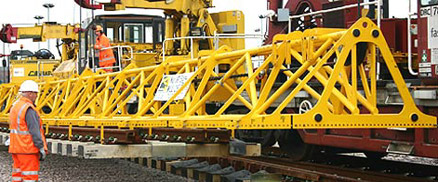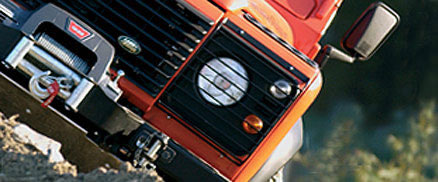March 29th, 2010
Before using a Norton track jack the operator should be familiar in its use. When raising a load operate the lever up and down. The jacks will raise the load one notch for each lever down stroke. The rack cannot be ratcheted out of the base because it is designed to stop when raised to its top limit.
To trip the jacks, raise the lever as high as it will go and disengage the short pawl by pulling on the pawl knob as far as it will go in the direction of the socket lever. Lower lever slightly to allow the short pawl to become locked against the long pawl, then release the short pawl and continue to lower lever until the long pawl is disengaged from the rack which trips the jack.
The following precautions and procedures should be followed when operating a Norton track jack:
- always visually inspect the jack before each shift or each use, whichever is less frequent.
- determine if the load is within the load rating of the jack otherwise it should not be used
- support the jacks firmly at the base in such a manner so that that it cannot shift under the load it is carrying.
- use shims or constraints to prevent slippage of the base or the load.
- use an operating lever of correct size and make sure the operating lever is properly seated in its socket.
- do not straddle the operating lever.
- remove operating levers when not in use to avoid dislocation of the jack and reduce the tripping hazard.
- take precaution to assure that all personnel are clear of the load before tripping.
- assure that sufficient swing area is available for the operating lever.
- avoid off-centre loading of jacks.
- lubricate the jack generously with grease frequently. This is recommended every 50 cycles. Apply the grease to bushing through holes at ends, to front and sides of the rack when extended and to the front of the base around the slot for the rack toe.
Posted in Arbil Rail |
March 28th, 2010
Falls kill more than 300 construction workers every year and hurt thousands. Deadly falls on the job are from unprotected roof edges, roof and floor openings, scaffolds, ladders, structural steel, leading edges, open shafts, and more. What you need to know:
Protect Yourself
- Whenever fall protection is needed, make sure you have the right fall-protection system, know how it works, get trained to use it – and use it.
- Where eliminating the hazard, guardrails, or safety nets won’t work, you need personal protective equipment (PPE) – fall-restraint systems, personal fall-arrest systems, or work positioning systems. Restraint systems keep you from falling. Fall-arrest systems stop falls. You will need a full-body harness if you use one of these systems.
- A full-body harness has straps worn around your trunk and thighs, with one or more D-rings in back to attach the harness to other parts of the system. If you fall, a properly fitted harness spreads the stopping force over your thighs, pelvis, chest, and shoulders.
Choosing a Harness
- Learn about the types of fall hazards on your job.
- Choose the right type of fall protection for each type of fall hazard. Never use a body belt, seat only harness, or chest-only harness for fall protection. Use a full-body harness instead.
- You can use a harness with an anchorage, a lanyard, a retractable lifeline, a vertical lifeline, a travel rail, a horizontal lifeline, a fall arrester, and/or a shock absorber. A fall-arrest system should let you fall no more than 6 feet. A work-positioning device should let you fall 2 feet or less.
- A registered professional engineer should design a fall protection system. A qualified person must supervise the setting up.
- Make sure the harness fits you and is comfortable, to prevent body strain. You can get shoulder and back pads to reduce harness pressure. Full-body cross-chest harnesses are more comfortable for women and can reduce bruising when falls are stopped.
Posted in Arbil Lifting Gear |
March 28th, 2010
For those of us that regularly head off the beaten track it goes without saying how important it is to be prepared for a recovery situation. If you wish to drive through very deep mud or climb a slippery slope and you know your vehicle will not be able to do it without some assistance then use of a snatch block to change the direction of pull may be the
solution. A useful piece of recovery equipment that should be included in your recovery gear is a snatch block which enables you to retrieve loads that are double a winch’s capacity by reducing the load on the winch by half.
Designed in Australia by ARB engineers, the Snatch Block 9000 features a revolutionary, computer optimised two-piece polymer pulley design for increased functionality and safety during a vehicle recovery. The Snatch Block 9000 has been tested to withstand the extremes of off-road competition winching. The snatch block features rounded safety edges to protect against pinch points during recovery situations, and also allows for easy one handed loading and unloading of the cable or rope. The working load encountered during winching also has a positive effect on the snatch block by causing the plates to press together for extra support.
Suitable for use with bow shackle sizes up to 8.5 ton, the snatch block features high strength, low density materials which reduce the total weight of the block by up to 50% over other comparable rated snatch blocks. The design includes self-righting plates to eliminate the need to correctly position the block while introducing cable tension, while the inner pulley is made from self lubricating crystalline polymer to enable operation under high loads without the need for lubrication.
The following uses and advantages are associated with using snatch blocks:
• Doubles pulling power.
• Winching from difficult angles.
• Overheating of electric winches reduced.
• Current draw is reduced and are therefore kinder to batteries.
Posted in Arbil 4x4 |


